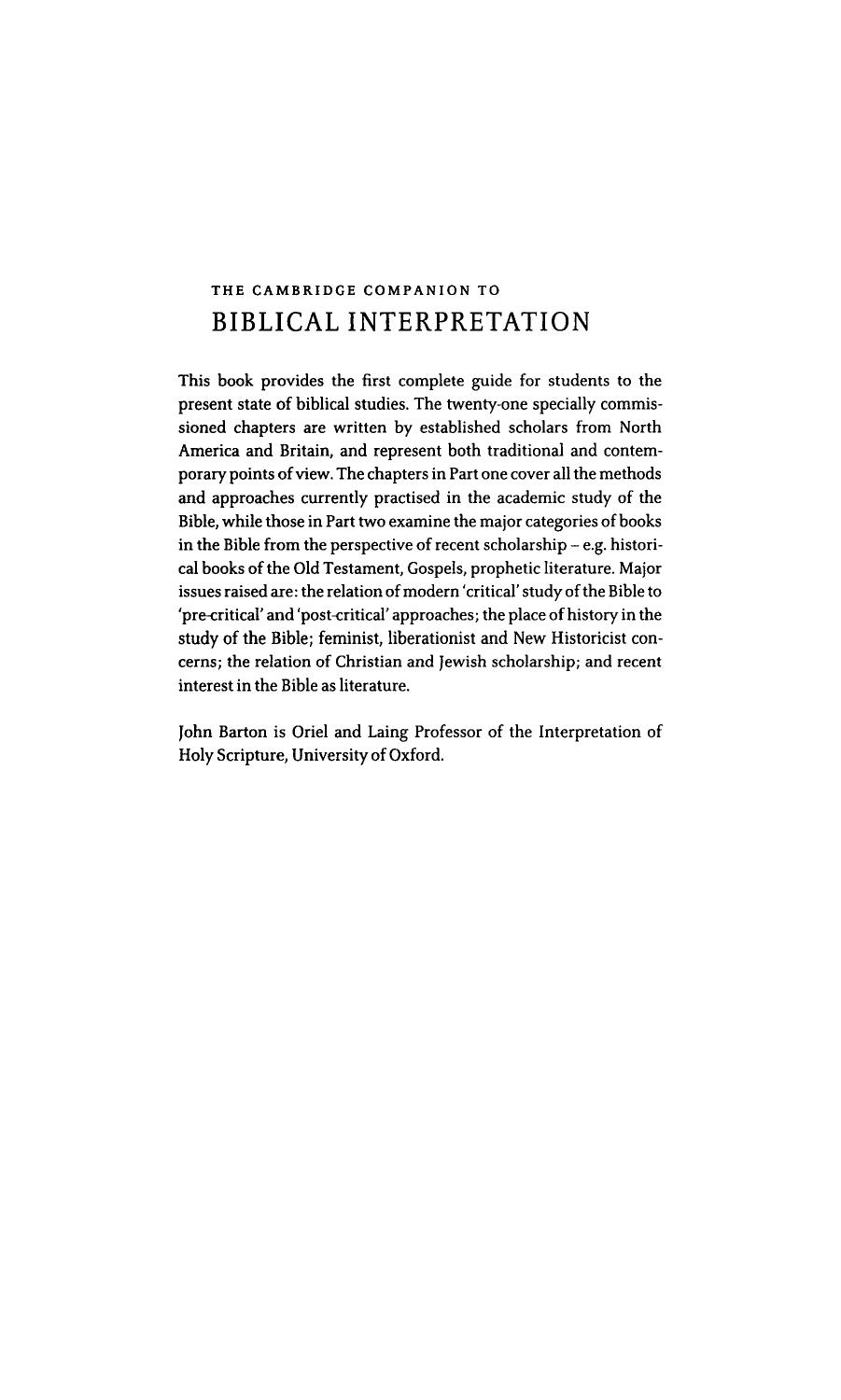The Cambridge Companion to Biblical Interpretation by John Barton

Author:John Barton [Barton, John]
Language: eng
Format: epub, pdf
Tags: Religion, Biblical Commentary, General
ISBN: 9780521481441
Google: IqwEngEACAAJ
Publisher: CambridgeUP
Published: 1998-11-15T00:19:13.585523+00:00
1. âParadise on Earthâ, Les Très Riches Heures du duc de Berry (Musée Condé, Chantilly) reproduced by permission of Giraudon.
It is this that links the picture with its audience. There is no attempt at proportion or perspective to position the viewer. The garden is the perfect circle required by theological tradition, not the ellipse it would appear to the eye, and the wall is made very low for us to see over it. The picture presents neither the illusion of space nor time. Everything is flat and simultaneous. Yet the realistic modelling of the figures, Eve, with a fashionable protruding belly, and Adam, whose kneeling posture is based on a Hellenistic statue still to be seen in the Museum of Aix-en-Provence, should remind us that the artist was neither anatomically incompetent nor unaware of the differences between his own style and that of the classical world that had preceded it. The loss of the antique knowledge of perspective with the coming of Christian art is often presented as a technical collapse, resulting in part from the wholesale and deliberate destruction of much of classical Roman art,10 but it should rather be seen as the logical outcome of exactly the same reinter-pretative process that had allegorized both the Hebrew scriptures and the classics.
Typology eliminates both time and space. To read in the story of Cain and Abel the type of the death of Christ, or in that of Jacob and Esau the type of Christians inheriting the blessing intended for the Jews, is to flatten history into a simultaneous panorama. To find in the Bible all things necessary for salvation, with the grand narrative of humanity beginning with the Creation in Genesis and concluding with the Apocalypse in Revelation, is to see all history in a timeless present composed of separable incidents related less to their own immediate context than to their typological place in the whole. In this respect, all the medieval arts show parallel characteristics. In music, the earlier Gregorian plainchant gave way to polyphonic forms, where the same words, phrase or sentence could be sung repetitively (as in a round) or even out of sequence â once again stressing simultaneity rather than linear temporal progression. While mosaic was invented in antiquity, it is no accident that it reached its height in early Christian art and architecture. Lacking any illusion of depth, its often highly decorated surface consisted of thousands of individual fragments relating to one another on a two-dimensional surface. Similarly, in their fragmentation and visual simultaneity, medieval painting and stained glass, like the carvings on the exteriors of churches and cathedrals, were entirely of a piece with the rest of medieval critical theory.
Download
The Cambridge Companion to Biblical Interpretation by John Barton.pdf
This site does not store any files on its server. We only index and link to content provided by other sites. Please contact the content providers to delete copyright contents if any and email us, we'll remove relevant links or contents immediately.
Machine Learning at Scale with H2O by Gregory Keys | David Whiting(3640)
Never by Ken Follett(3532)
Fairy Tale by Stephen King(2952)
The Man Who Died Twice by Richard Osman(2811)
Reminders of Him: A Novel by Colleen Hoover(2768)
Will by Will Smith(2581)
Rationality by Steven Pinker(2150)
It Starts With Us (It Ends with Us #2) by Colleen Hoover(2044)
Can't Hurt Me: Master Your Mind and Defy the Odds - Clean Edition by David Goggins(2004)
Friends, Lovers, and the Big Terrible Thing by Matthew Perry(1998)
The Stranger in the Lifeboat by Mitch Albom(1936)
The Becoming by Nora Roberts(1919)
Love on the Brain by Ali Hazelwood(1818)
New Morning Mercies: A Daily Gospel Devotional by Paul David Tripp(1814)
HBR's 10 Must Reads 2022 by Harvard Business Review(1698)
The Strength In Our Scars by Bianca Sparacino(1695)
A Short History of War by Jeremy Black(1671)
Never Finished: Unshackle Your Mind and Win the War Within by David Goggins(1558)
515945210 by Unknown(1521)
